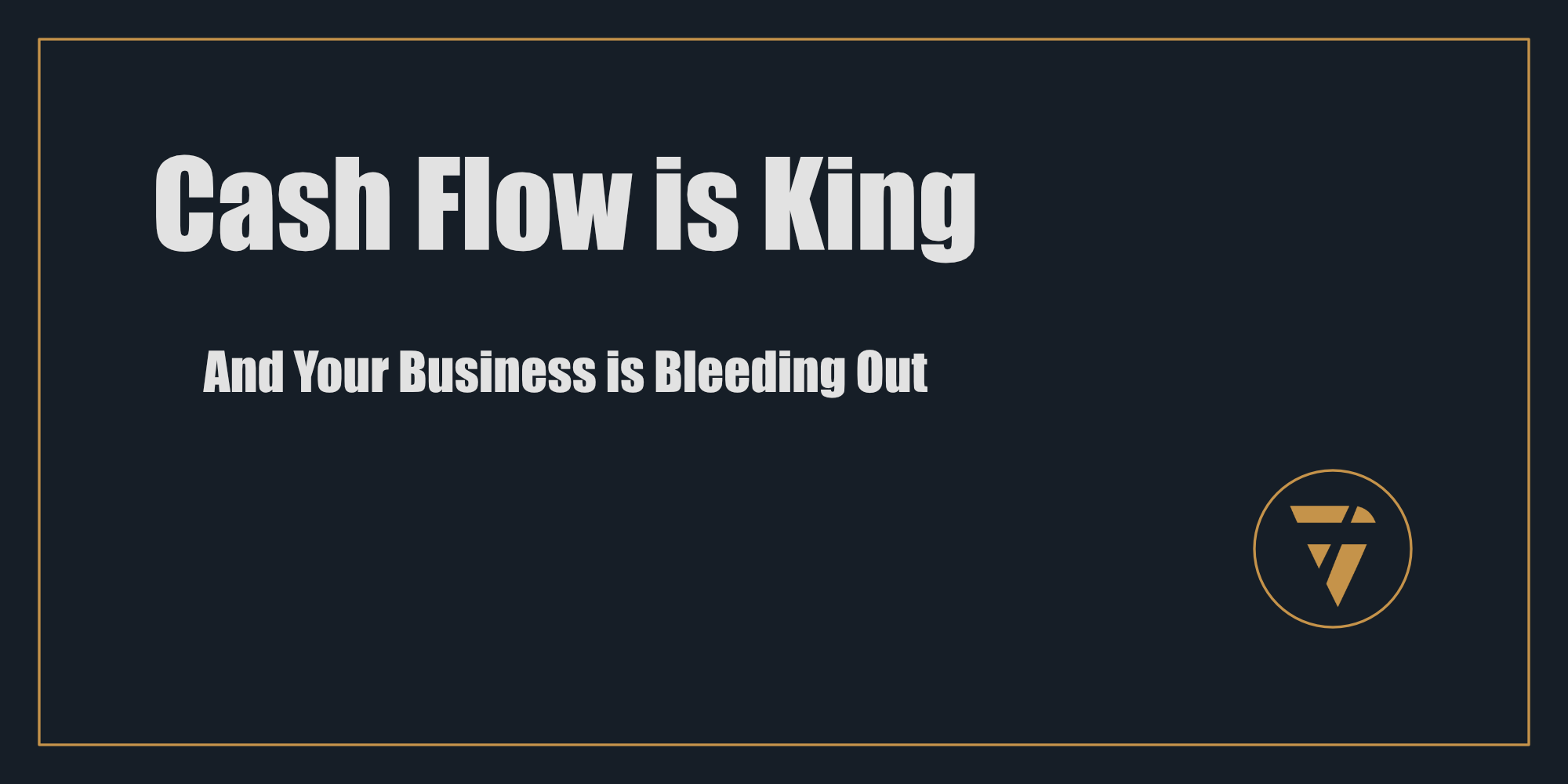Cash Flow is King

And Your Business is Bleeding Out
In a stable market, businesses can afford to play the long game. They invest in growth, take on debt, expand operations, and assume that revenue will continue to flow.
In a collapsing market, none of that matters, because cash flow is the difference between survival and bankruptcy.
Businesses do not fail because they are not profitable. They fail because they run out of cash.
Right now, Canadian businesses are running out of cash at an alarming rate. High-interest rates are crushing loans and credit lines. Customers are spending less. Discretionary purchases are drying up. Vendors are demanding faster payments. Many suppliers are tightening terms or requiring upfront payments. Government aid is unreliable. Banks are pulling back, and funding is scarce.
If you are waiting for things to normalize, you are already losing the game.
Cash flow is not just an accounting metric. It is your business’s life force. Without it, your doors close, your payroll stops, and your options disappear.
The question is not whether your business is struggling. It's how much time you have left before your cash runs dry.
This is your wake-up call. You need to take action now.
Common Mistakes Business Owners Make When Panic Sets In
When cash flow starts bleeding, most business owners react emotionally. They make decisions based on fear rather than strategy.
Here is what not to do.
Slashing the wrong costs. Most businesses cut expenses blindly, killing essential revenue-driving activities. They slash marketing, fire key employees, or abandon customer service, and accelerate their own collapse.
Instead, cut costs strategically.
Taking on bad debt. In desperation, some businesses max out credit lines or take emergency loans with brutal terms, high interest rates, predatory repayment structures, or personal guarantees that put their entire future at risk.
Instead, secure capital before you're desperate, and restructure existing debt.
Chasing revenue at any cost. A crisis makes businesses think they need to sell more at all costs. But desperate, unprofitable sales can worsen your cash position by increasing expenses, extending receivables, or locking you into bad contracts.
Instead, focus on high-margin, fast-cash revenue strategies.
Cutting the Right Costs (and Not the Wrong Ones)
Not all expenses are created equal. Some keep your business alive, while others are draining your cash for no reason.
The Costs You Should Cut Immediately
- Vanity Expenses: If it does not bring in revenue or save essential resources, it goes. Fancy office spaces, unnecessary software, and luxury perks need to go now.
- Unused Subscriptions and Tools: Look through every automated payment. Cut or downgrade any software, platform, or tool you are not actively using.
- Underperforming Ad Spend: Cut marketing that does not convert. Focus only on high-ROI, revenue-driving marketing efforts.
- Non-Essential Inventory: Holding excessive stock? Sell it off now before demand shrinks further.
- Expensive Vendors: Renegotiate contracts or switch to more affordable alternatives.
The Costs You Must Protect at All Costs
- Revenue-Generating Activities: If it directly leads to sales, customer retention, or cash flow, keep it. This includes effective ads, high-performing sales staff, and service delivery.
- Core Team Members: Layoffs might seem necessary, but if you cut the wrong people, you cripple your ability to recover. Focus on keeping the most valuable employees.
- Customer Retention Efforts: Losing customers is more expensive than keeping them. Retention programs, customer support, and loyalty initiatives must remain in place.
- Key Supplier Relationships: The last thing you need is losing critical suppliers over unpaid invoices. Work out payment plans instead of burning bridges.
This is not about slashing costs recklessly. It's about precision. Cut what does not serve you, and protect what does.
The Power of the Liquidation Audit: Identifying Hidden Capital
Most businesses have untapped cash hidden in plain sight. The problem is they never look for it.
A liquidation audit is a systematic review of every asset you own, physical or digital, to find hidden cash that can be freed up immediately.
How to Conduct a Liquidation Audit
- List All Assets
- Inventory (raw materials, unsold products, excess stock)
- Equipment (unused machines, office furniture, electronics)
- Digital Assets (domains, old websites, intellectual property)
- Real Estate (unused space, storage, vehicles)
- Identify What Can Be Sold or Leveraged
- Sell non-essential inventory at a discount.
- Liquidate old equipment through online marketplaces.
- License unused digital assets for passive income.
- Sublease office space or rent out assets.
- Convert Dead Capital into Cash
- Run a clearance sale on old stock.
- Offer bulk discounts to clear inventory fast.
- Approach buyers in your industry who may need excess materials.
A well-executed liquidation audit can inject immediate cash into your business, often without taking on new debt.
Actionable Tactics: A 30-Day Emergency Cash Flow Stabilization Plan
If your business has less than 90 days of cash left, you need an immediate stabilization plan.
Here is how to stop the bleeding in 30 days.
Day 1-7: Stop the Bleeding
- Freeze all unnecessary spending. No exceptions.
- Conduct a 24-hour liquidation audit. Sell non-essential inventory.
- Review and cut wasteful expenses. Cancel non-essential subscriptions.
- Renegotiate rent, supplier payments, and loan terms.
Day 8-14: Secure Immediate Cash Injections
- Send invoices early and offer discounts for upfront payments.
- Call late-paying customers and collect outstanding receivables.
- Negotiate faster payouts from existing contracts.
- Seek trade financing, supplier credit, or alternative funding.
Day 15-21: Increase Revenue with Quick-Win Strategies
- Launch a fast cash offer (discounted bundles, prepaid deals).
- Upsell existing customers with urgent-value offers.
- Increase prices strategically on high-demand products.
- Expand into service-based revenue if product sales are slow.
Day 22-30: Implement Long-Term Cash Flow Systems
- Automate accounts receivable. Send invoices faster and more frequently.
- Shift toward subscription or recurring revenue models.
- Establish a cash reserve policy—three to six months of operating costs in cash.
- Monitor financial health weekly. Not monthly. Not quarterly. Weekly.
The Businesses That Survive Will Control Their Cash Flow—Not Gamble on Hope
Hope is not a financial strategy. Cash flow is.
The businesses that act now, who protect their liquidity, cut intelligently, and secure new revenue streams, will outlast and outperform the ones that hesitate.
Your move. Will you control your cash, or will your cash situation control you?
This is what I’m working on. Tell me what you think, I enjoy the conversation! Subscribe and follow the work in real time.
Thanks!
B

Cash flow is the difference between survival and bankruptcy. Cut the wrong costs, and you bleed out. Wait too long, and the banks take control.
Act now. Control your liquidity, or lose everything.
PS -






